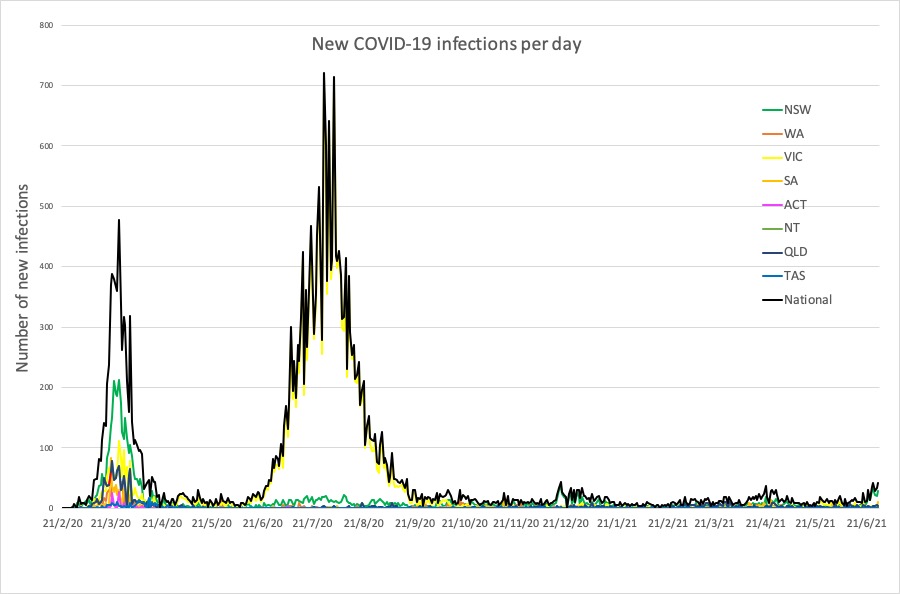And exercising with a mask doesn't slow you down, study finds.
Welcome to The Medical Republic’s COVID Catch-Up.
It’s the day’s covid-19 news in one convenient post. Email bianca@biancanogrady.com with any tips, comments or feedback.
1 July
- Novavax covid vaccine shows nearly 90% efficacy in phase 3 trial.
- Exercising with mask on doesn’t slow you down, study finds.
- Case series of 23 adults with myocarditis linked to mRNA vaccine.
- All quarantine workers, including drivers, now required to be tested daily.
- Victoria, ACT and Tasmania have zero community-acquired cases, while rest of Australia wrestles with outbreaks.
- Latest covid-19 infection rates from around Australia.
The two-dose Novavax vaccine has shown 89.7% efficacy in preventing symptomatic covid-19, according to a phase 3 , placebo-controlled study in just over 14,000 participants published in the New England Journal of Medicine.
The vaccine is based on recombinant nanoparticle spike proteins, with two doses given 21 days apart.
The study population was around 48% female and 94% white, and 44% had at least one comorbidity associated with an increased risk of worse outcomes from covid infection.
At seven days after the second dose, 10 in the vaccine group and 96 in the placebo group had contracted covid, representing a vaccine efficacy of 89.7%.
Eight of the infections in the vaccinated group were caused by the alpha variant of SARS-CoV-2, one was caused by a different variant and one could not be identified. However none were severe infections requiring hospitalisation, while five cases in the placebo group were considered severe.
Two participants died from covid: one in the vaccine group, who was infected shortly after the first dose of the vaccine, and one in the placebo group.
One half to three-quarters of those in the vaccine group reported injection site tenderness or pain after the first and second doses, while the most common systemic adverse events were headache, muscle pain, and fatigue. There were no cases of anaphylaxis associated with the vaccine and no clotting events reported.
You can still exercise normally while wearing a mask, although peak oxygen intake and heart rates may be slightly lower than usual, a study has found.
Twenty non-smoking fit and healthy volunteers were tested on treadmill exercises while wearing a cloth mask, N95 respirator or neither. They started at their own pace and the grade of the treadmill was increased until they tapped out.
The study, published in JAMA Network Open, found that while wearing a mask meant lower peak oxygen levels and lower peak heart rates compared to no masks, none of the participants had to stop their exercise because of clinical concerns.
“Thus, although it is possible that wearing a mask exerted a physical limitation on exercise capacity, the clinical relevance of such a possibility is not supported by these data,” the authors wrote.
A retrospective case series of 23 otherwise healthy individuals who developed myocarditis after receiving a dose of mRNA vaccine suggests that prior exposure – either through SARS-CoV-2 infection or a first dose of the vaccine – is a factor.
A paper published in JAMA Cardiology reported on 23 males in the US military who presented with acute chest pain and elevated cardiac troponin levels after either their first or second dose of the Pfizer or Moderna vaccines.
Nineteen of the patients had abnormal electrocardiography findings and four had reduced left ventricular ejection fractions. Symptoms resolved within one week for 16 patients, and the remaining seven still had ongoing chest discomfort.
Anyone involved in managed quarantine in Australia – including those involved in driving quarantined individuals – will now be tested daily for covid-19, as the Australian Health Protection Principal Committee updates its recommendations for vaccination and testing of quarantine workers.
With the current Bondi outbreak traced back to one unvaccinated airport limousine driver transporting international passengers and flight crew, AHPPC has expanded its November 2020 recommendation for daily testing of quarantine staff to include “all workers directly and indirectly involved in managed quarantine”, including drivers.
New South Wales has gone one step further and is now requiring all airport drivers to be vaccinated and to wear a mask when transporting passengers.
While the covid-19 infection numbers in Sydney appear to be holding steady for now, more than half of the 24 cases reported today were in the community while infectious, including a nurse who worked four days at Fairfield and Royal North Shore hospitals.
The Bondi outbreak cluster now numbers 175 infections, and there have been a total of 195 locally acquired cases in NSW since the outbreak began. At the moment there are two individuals in intensive care, and one on a ventilator.
South Australia reported five new locally acquired cases yesterday, all linked to the Northern Territory’s Tanami mine case. Queensland has three locally-acquired cases, and Northern Territory also reported another case linked to the Tanami mine cluster. Western Australia has had one new locally-acquired case connected to two earlier cases.
A big hooray for Victoria, which has had no locally acquired cases in the last 24 hours, while Tasmania and the ACT continue to hold the line having had no new cases since 10 December 2020 and 29 March 2021 respectively.
Globally, new infections reported in the last week have been similar in number to the previous week, although this plateau conceals significant increases in countries including Namibia, Russia, India, Colombia and Mongolia.
But the good news in the latest WHO update is that deaths dropped 10% in the last week compared to the previous week.
Here are the latest covid-19 infection numbers from around Australia to 9pm Wednesday:
National – 30,610 with 910 deaths
ACT – 124 (0)
NSW – 5826 (28)
NT – 184 (0)
QLD – 1696 (4)
SA – 807 (11)
TAS – 234 (0)
VIC – 20,712 (2)
WA – 1027 (3)



